Cultural Difference Between Indigenous and Western People
VerifiedAdded on 2022/12/01
|6
|1425
|460
AI Summary
This report explores the various differences between the indigenous group and the western worldview. It discusses the challenges faced by the first people due to the cultural differences that exist between the two groups.
Contribute Materials
Your contribution can guide someone’s learning journey. Share your
documents today.
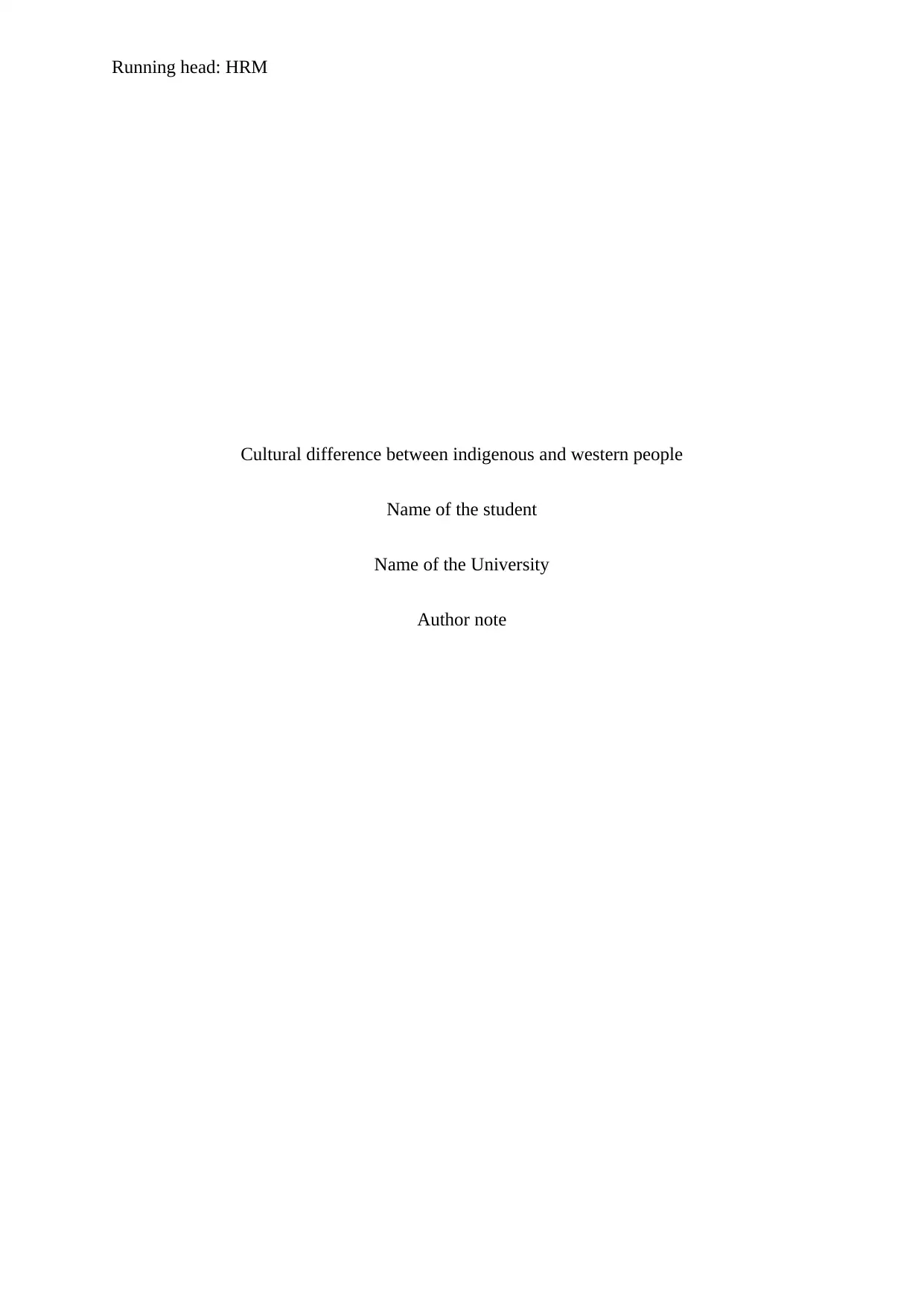
Running head: HRM
Cultural difference between indigenous and western people
Name of the student
Name of the University
Author note
Cultural difference between indigenous and western people
Name of the student
Name of the University
Author note
Secure Best Marks with AI Grader
Need help grading? Try our AI Grader for instant feedback on your assignments.
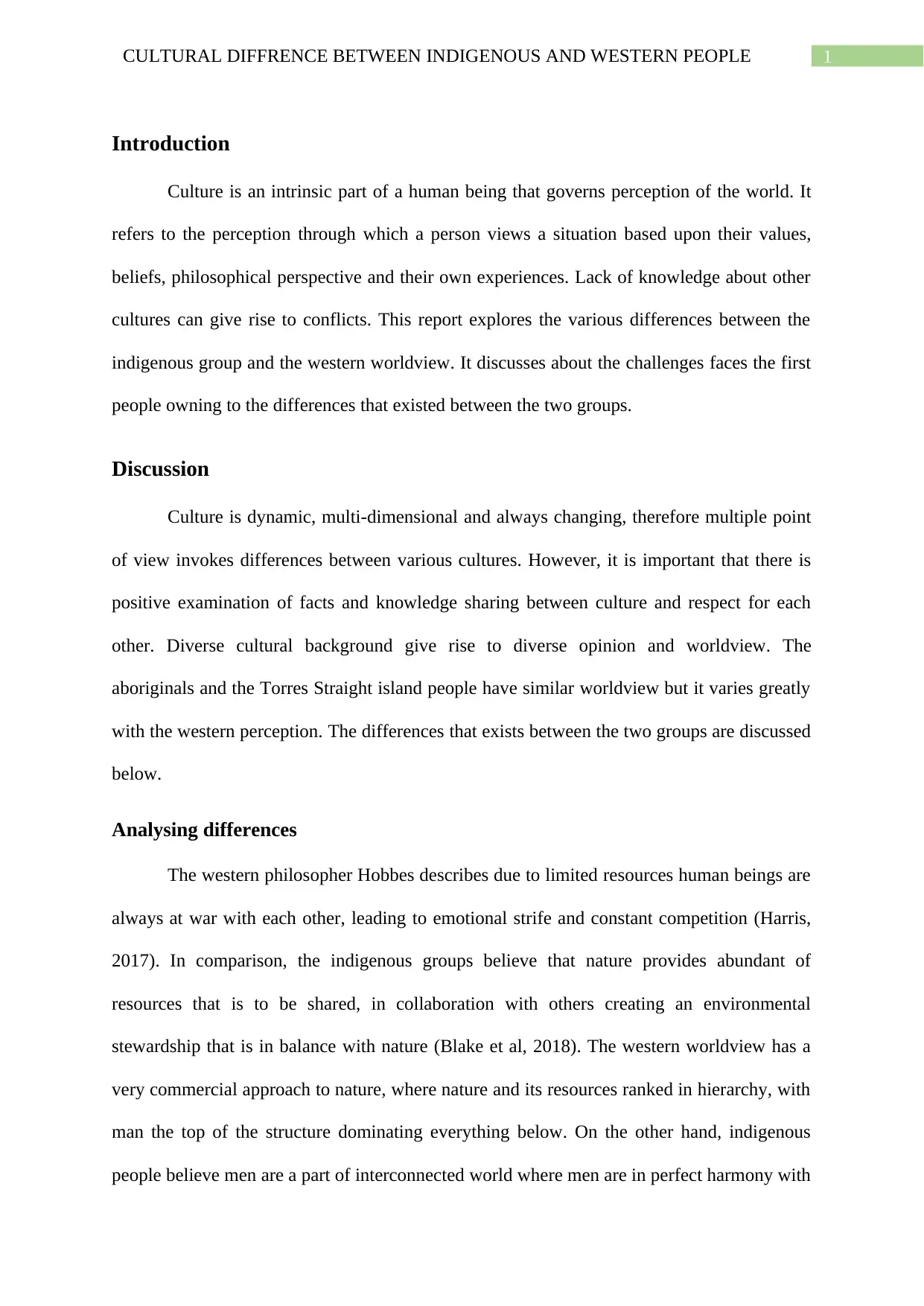
1CULTURAL DIFFRENCE BETWEEN INDIGENOUS AND WESTERN PEOPLE
Introduction
Culture is an intrinsic part of a human being that governs perception of the world. It
refers to the perception through which a person views a situation based upon their values,
beliefs, philosophical perspective and their own experiences. Lack of knowledge about other
cultures can give rise to conflicts. This report explores the various differences between the
indigenous group and the western worldview. It discusses about the challenges faces the first
people owning to the differences that existed between the two groups.
Discussion
Culture is dynamic, multi-dimensional and always changing, therefore multiple point
of view invokes differences between various cultures. However, it is important that there is
positive examination of facts and knowledge sharing between culture and respect for each
other. Diverse cultural background give rise to diverse opinion and worldview. The
aboriginals and the Torres Straight island people have similar worldview but it varies greatly
with the western perception. The differences that exists between the two groups are discussed
below.
Analysing differences
The western philosopher Hobbes describes due to limited resources human beings are
always at war with each other, leading to emotional strife and constant competition (Harris,
2017). In comparison, the indigenous groups believe that nature provides abundant of
resources that is to be shared, in collaboration with others creating an environmental
stewardship that is in balance with nature (Blake et al, 2018). The western worldview has a
very commercial approach to nature, where nature and its resources ranked in hierarchy, with
man the top of the structure dominating everything below. On the other hand, indigenous
people believe men are a part of interconnected world where men are in perfect harmony with
Introduction
Culture is an intrinsic part of a human being that governs perception of the world. It
refers to the perception through which a person views a situation based upon their values,
beliefs, philosophical perspective and their own experiences. Lack of knowledge about other
cultures can give rise to conflicts. This report explores the various differences between the
indigenous group and the western worldview. It discusses about the challenges faces the first
people owning to the differences that existed between the two groups.
Discussion
Culture is dynamic, multi-dimensional and always changing, therefore multiple point
of view invokes differences between various cultures. However, it is important that there is
positive examination of facts and knowledge sharing between culture and respect for each
other. Diverse cultural background give rise to diverse opinion and worldview. The
aboriginals and the Torres Straight island people have similar worldview but it varies greatly
with the western perception. The differences that exists between the two groups are discussed
below.
Analysing differences
The western philosopher Hobbes describes due to limited resources human beings are
always at war with each other, leading to emotional strife and constant competition (Harris,
2017). In comparison, the indigenous groups believe that nature provides abundant of
resources that is to be shared, in collaboration with others creating an environmental
stewardship that is in balance with nature (Blake et al, 2018). The western worldview has a
very commercial approach to nature, where nature and its resources ranked in hierarchy, with
man the top of the structure dominating everything below. On the other hand, indigenous
people believe men are a part of interconnected world where men are in perfect harmony with
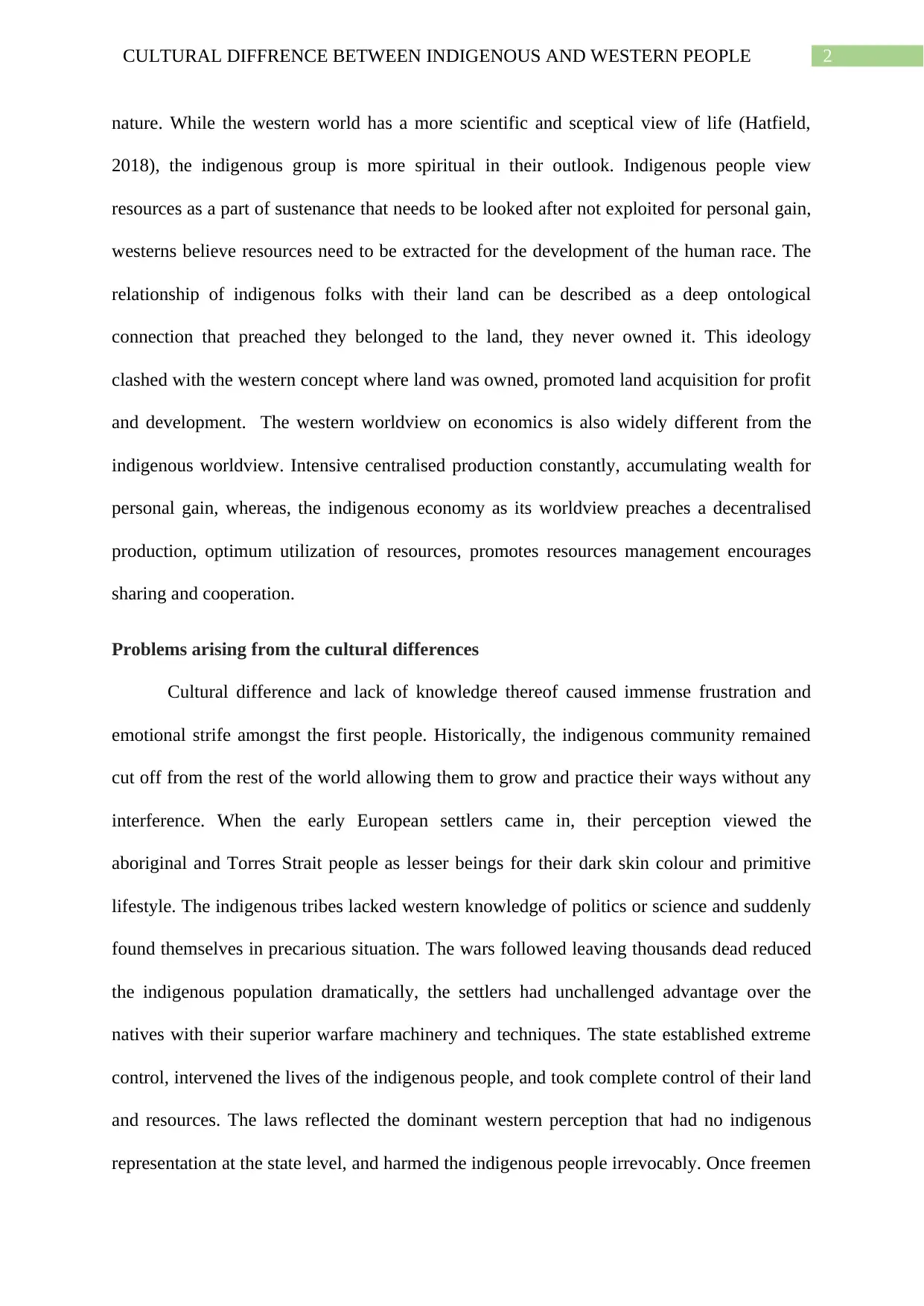
2CULTURAL DIFFRENCE BETWEEN INDIGENOUS AND WESTERN PEOPLE
nature. While the western world has a more scientific and sceptical view of life (Hatfield,
2018), the indigenous group is more spiritual in their outlook. Indigenous people view
resources as a part of sustenance that needs to be looked after not exploited for personal gain,
westerns believe resources need to be extracted for the development of the human race. The
relationship of indigenous folks with their land can be described as a deep ontological
connection that preached they belonged to the land, they never owned it. This ideology
clashed with the western concept where land was owned, promoted land acquisition for profit
and development. The western worldview on economics is also widely different from the
indigenous worldview. Intensive centralised production constantly, accumulating wealth for
personal gain, whereas, the indigenous economy as its worldview preaches a decentralised
production, optimum utilization of resources, promotes resources management encourages
sharing and cooperation.
Problems arising from the cultural differences
Cultural difference and lack of knowledge thereof caused immense frustration and
emotional strife amongst the first people. Historically, the indigenous community remained
cut off from the rest of the world allowing them to grow and practice their ways without any
interference. When the early European settlers came in, their perception viewed the
aboriginal and Torres Strait people as lesser beings for their dark skin colour and primitive
lifestyle. The indigenous tribes lacked western knowledge of politics or science and suddenly
found themselves in precarious situation. The wars followed leaving thousands dead reduced
the indigenous population dramatically, the settlers had unchallenged advantage over the
natives with their superior warfare machinery and techniques. The state established extreme
control, intervened the lives of the indigenous people, and took complete control of their land
and resources. The laws reflected the dominant western perception that had no indigenous
representation at the state level, and harmed the indigenous people irrevocably. Once freemen
nature. While the western world has a more scientific and sceptical view of life (Hatfield,
2018), the indigenous group is more spiritual in their outlook. Indigenous people view
resources as a part of sustenance that needs to be looked after not exploited for personal gain,
westerns believe resources need to be extracted for the development of the human race. The
relationship of indigenous folks with their land can be described as a deep ontological
connection that preached they belonged to the land, they never owned it. This ideology
clashed with the western concept where land was owned, promoted land acquisition for profit
and development. The western worldview on economics is also widely different from the
indigenous worldview. Intensive centralised production constantly, accumulating wealth for
personal gain, whereas, the indigenous economy as its worldview preaches a decentralised
production, optimum utilization of resources, promotes resources management encourages
sharing and cooperation.
Problems arising from the cultural differences
Cultural difference and lack of knowledge thereof caused immense frustration and
emotional strife amongst the first people. Historically, the indigenous community remained
cut off from the rest of the world allowing them to grow and practice their ways without any
interference. When the early European settlers came in, their perception viewed the
aboriginal and Torres Strait people as lesser beings for their dark skin colour and primitive
lifestyle. The indigenous tribes lacked western knowledge of politics or science and suddenly
found themselves in precarious situation. The wars followed leaving thousands dead reduced
the indigenous population dramatically, the settlers had unchallenged advantage over the
natives with their superior warfare machinery and techniques. The state established extreme
control, intervened the lives of the indigenous people, and took complete control of their land
and resources. The laws reflected the dominant western perception that had no indigenous
representation at the state level, and harmed the indigenous people irrevocably. Once freemen

3CULTURAL DIFFRENCE BETWEEN INDIGENOUS AND WESTERN PEOPLE
found their freedom snatched, landless, starved and treated as outsiders in their own
motherland. Reduced resources forced the natives to use their kinship system to barter labour
for food, the settlers perceived this as an opportunity to exploit. The natives received different
treatment for their “race” and subjected to western atrocities such as introduced them to
diseases such as small pox, poisoned food and others. This increased death rates and reduced
birth rates reducing their population (Adams et al, 2018).
Contemporary issues
Laws such as Aborigines Protection Act 1909, Aborigines Act 1905, and Welfare
Ordinance 1953 created self-serving, abusive and restrictive practices on the natives to cater
to the advantages of the whites. The natives were subjected to atrocious laws that stemmed
from racist beliefs. Children who were part white were separated from their families to
mainstream them into the white society. The stolen generation led to disintegration of
families, caused deep psychological damage between the child and the parents, led to
alienation of the child, destroyed communities and established racism more dominantly
(O’Donnell et al, 2019). The assimilation of these children into the white society had a more
sinister approach that aimed at changing the relationship between the natives and their
environment altogether. The effects of which is still visible today. Studies show higher infant
mortality rate, higher mental behavioural maladjustments, experience higher victimisation
rate. There is better representation of the natives today and more measures is being taken by
the government as well the natives to preserve and advocate their culture (Nelson, 2018).
Conclusion
Schools have introduced curriculum where island, aboriginal and the non-indigenous
are taught about each other’s cultural to increase cultural competency and obliterate harmful
practices (Forrest, Lean & Dunn, 2016). Indigenous group members are able to represent
found their freedom snatched, landless, starved and treated as outsiders in their own
motherland. Reduced resources forced the natives to use their kinship system to barter labour
for food, the settlers perceived this as an opportunity to exploit. The natives received different
treatment for their “race” and subjected to western atrocities such as introduced them to
diseases such as small pox, poisoned food and others. This increased death rates and reduced
birth rates reducing their population (Adams et al, 2018).
Contemporary issues
Laws such as Aborigines Protection Act 1909, Aborigines Act 1905, and Welfare
Ordinance 1953 created self-serving, abusive and restrictive practices on the natives to cater
to the advantages of the whites. The natives were subjected to atrocious laws that stemmed
from racist beliefs. Children who were part white were separated from their families to
mainstream them into the white society. The stolen generation led to disintegration of
families, caused deep psychological damage between the child and the parents, led to
alienation of the child, destroyed communities and established racism more dominantly
(O’Donnell et al, 2019). The assimilation of these children into the white society had a more
sinister approach that aimed at changing the relationship between the natives and their
environment altogether. The effects of which is still visible today. Studies show higher infant
mortality rate, higher mental behavioural maladjustments, experience higher victimisation
rate. There is better representation of the natives today and more measures is being taken by
the government as well the natives to preserve and advocate their culture (Nelson, 2018).
Conclusion
Schools have introduced curriculum where island, aboriginal and the non-indigenous
are taught about each other’s cultural to increase cultural competency and obliterate harmful
practices (Forrest, Lean & Dunn, 2016). Indigenous group members are able to represent
Paraphrase This Document
Need a fresh take? Get an instant paraphrase of this document with our AI Paraphraser
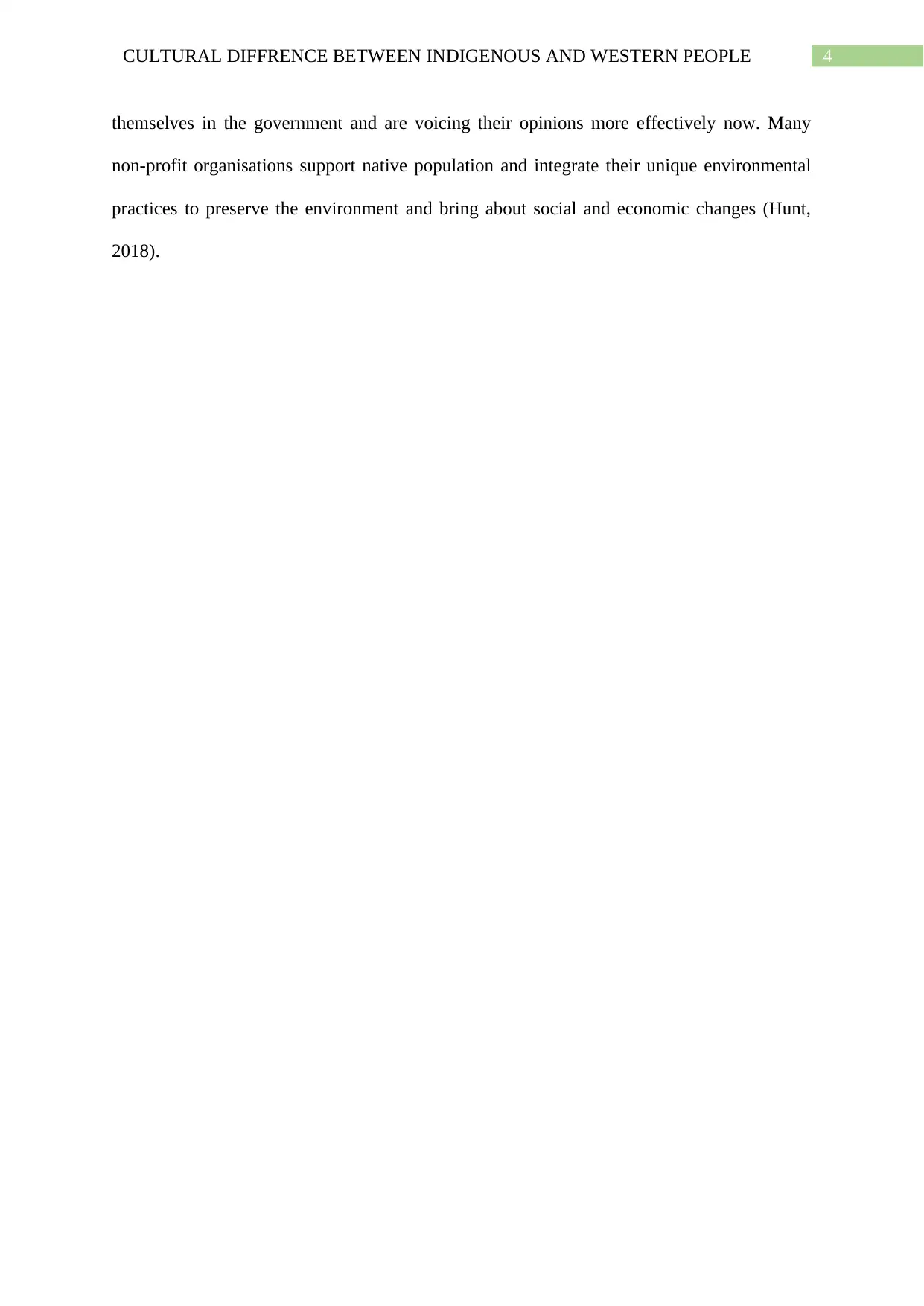
4CULTURAL DIFFRENCE BETWEEN INDIGENOUS AND WESTERN PEOPLE
themselves in the government and are voicing their opinions more effectively now. Many
non-profit organisations support native population and integrate their unique environmental
practices to preserve the environment and bring about social and economic changes (Hunt,
2018).
themselves in the government and are voicing their opinions more effectively now. Many
non-profit organisations support native population and integrate their unique environmental
practices to preserve the environment and bring about social and economic changes (Hunt,
2018).
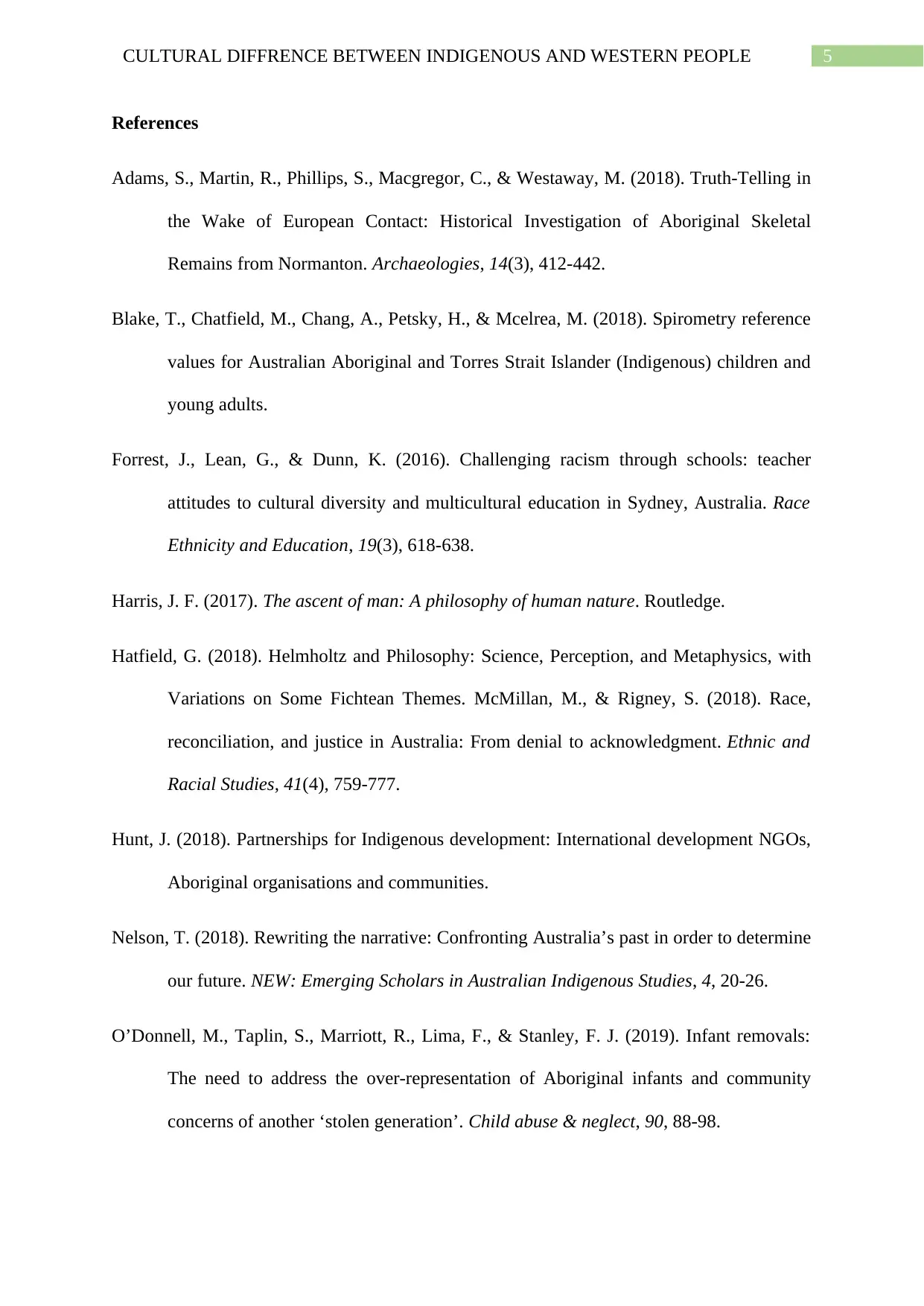
5CULTURAL DIFFRENCE BETWEEN INDIGENOUS AND WESTERN PEOPLE
References
Adams, S., Martin, R., Phillips, S., Macgregor, C., & Westaway, M. (2018). Truth-Telling in
the Wake of European Contact: Historical Investigation of Aboriginal Skeletal
Remains from Normanton. Archaeologies, 14(3), 412-442.
Blake, T., Chatfield, M., Chang, A., Petsky, H., & Mcelrea, M. (2018). Spirometry reference
values for Australian Aboriginal and Torres Strait Islander (Indigenous) children and
young adults.
Forrest, J., Lean, G., & Dunn, K. (2016). Challenging racism through schools: teacher
attitudes to cultural diversity and multicultural education in Sydney, Australia. Race
Ethnicity and Education, 19(3), 618-638.
Harris, J. F. (2017). The ascent of man: A philosophy of human nature. Routledge.
Hatfield, G. (2018). Helmholtz and Philosophy: Science, Perception, and Metaphysics, with
Variations on Some Fichtean Themes. McMillan, M., & Rigney, S. (2018). Race,
reconciliation, and justice in Australia: From denial to acknowledgment. Ethnic and
Racial Studies, 41(4), 759-777.
Hunt, J. (2018). Partnerships for Indigenous development: International development NGOs,
Aboriginal organisations and communities.
Nelson, T. (2018). Rewriting the narrative: Confronting Australia’s past in order to determine
our future. NEW: Emerging Scholars in Australian Indigenous Studies, 4, 20-26.
O’Donnell, M., Taplin, S., Marriott, R., Lima, F., & Stanley, F. J. (2019). Infant removals:
The need to address the over-representation of Aboriginal infants and community
concerns of another ‘stolen generation’. Child abuse & neglect, 90, 88-98.
References
Adams, S., Martin, R., Phillips, S., Macgregor, C., & Westaway, M. (2018). Truth-Telling in
the Wake of European Contact: Historical Investigation of Aboriginal Skeletal
Remains from Normanton. Archaeologies, 14(3), 412-442.
Blake, T., Chatfield, M., Chang, A., Petsky, H., & Mcelrea, M. (2018). Spirometry reference
values for Australian Aboriginal and Torres Strait Islander (Indigenous) children and
young adults.
Forrest, J., Lean, G., & Dunn, K. (2016). Challenging racism through schools: teacher
attitudes to cultural diversity and multicultural education in Sydney, Australia. Race
Ethnicity and Education, 19(3), 618-638.
Harris, J. F. (2017). The ascent of man: A philosophy of human nature. Routledge.
Hatfield, G. (2018). Helmholtz and Philosophy: Science, Perception, and Metaphysics, with
Variations on Some Fichtean Themes. McMillan, M., & Rigney, S. (2018). Race,
reconciliation, and justice in Australia: From denial to acknowledgment. Ethnic and
Racial Studies, 41(4), 759-777.
Hunt, J. (2018). Partnerships for Indigenous development: International development NGOs,
Aboriginal organisations and communities.
Nelson, T. (2018). Rewriting the narrative: Confronting Australia’s past in order to determine
our future. NEW: Emerging Scholars in Australian Indigenous Studies, 4, 20-26.
O’Donnell, M., Taplin, S., Marriott, R., Lima, F., & Stanley, F. J. (2019). Infant removals:
The need to address the over-representation of Aboriginal infants and community
concerns of another ‘stolen generation’. Child abuse & neglect, 90, 88-98.
1 out of 6
![[object Object]](/_next/static/media/star-bottom.7253800d.svg)




